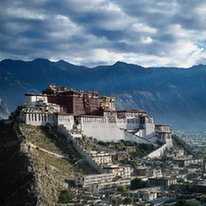不少人关心中国的“西藏问题”。在他们的头脑里,总闪烁着一个带着东方神秘主义色彩的,朦胧、理想的“香格里拉”。历史确凿地记载着,旧西藏并不是一些人想象的“香格里拉”。1950年全西藏有100万人,其中90万人没有住房,拉萨城区只有2万人,露宿街头的贫民和乞丐就达1000多人。如今的西藏,人均寿命已从旧西藏的35.5岁,增长到67岁,经济连续7年保持12%以上的增长速度,大大高于全国的平均发展速度。对比解放前后的西藏,任何人都不难得出答案,到底哪个才是真正的“香格里拉”。

 |
|
Tibet is indeed as mysterious as anything you might have imagined about Shangri-La. The elegance and beauty of the snow-capped plateau, the uniqueness of its linguistic culture, and the canon of Tibetan Buddhism are all parts of human culture with special ethnic features which we cherish more than any other people.
|
Many Westerners are concerned about the "Tibet Issue." It is said that the image of a mysterious, vague and ideal Eastern "Shangri-La" always lingers in their minds.
Tibet is indeed as mysterious as anything you might have imagined about Shangri-La. The elegance and beauty of the snow-capped plateau, the uniqueness of its linguistic culture, and the canon of Tibetan Buddhism are all parts of human culture with special ethnic features which we cherish more than any other people.
To protect the Tibetan culture, the Chinese government has spent heavily to renovate the Potala Palace, the Norbulingka and the Sakya Monastery. Unprecedented renovation of 22 temples and monasteries as well as ancient historical relics started early this year. The government has conducted a program of Collation and Study of Tibetan Sutra and brought over 100 Tibetan linguists to compile and collate different versions of Tibetan Sutra for publication.
To protect the blue sky and clean water, the Chinese government will invest over 22 billion yuan ($3.19 billion) to build at least 160 projects until the middle of this century.
The mountains, the rivers, the Tibetan Script Banners, and the names of the Buddha remain unchanged.
Nevertheless, as Canadian scholar A. Tom Grunfeld writes in The Making of Modern Tibet, "Tibet is a land so wrapped in obscurity that almost any fantastic tales about it, or allegedly from it, are received with awe and believed, unquestioningly, by countless individuals in the world . Many call themselves 'experts' after reading a mere handful of texts, assuming that the uniformity of these accounts indicates their accuracy."
The history clearly reveals that the old Tibet was not the Shangri-La that many imagine, but a society under a system offeudal serfdom. The serf owners, the political leaders and the heads of the temples, accounting for less than 5 percent of the total population of old Tibet, possessed almost 98 percent of the land and most of the livestock.
And the Dalai Lama, was the largest and most powerful serf owner. The Sixteen Codes of the old Tibet stated, "the rebels and the subordinate acting against the supreme were those who committed severe crimes and they were to have their eyes gouged, to be hamstrung, to have their tongues cut out, to have their arms broken or to be killed immediately." In the old Tibet, both economy and culture was in terrible shape and the population did not even grow.
Today, Tibet certainly needs to protect its unique Tibetan culture and the culture of Shangri-La, but definitely should not retain its brutality and backwardness. The protection of Tibetan culture has to go along with the development, progress, unity and happiness of the whole Tibetan population. Otherwise, it will become a living fossil, which has neither life nor vitality. The essential difference between the Dalai Lama and the Chinese government does not lie in the question whether there is a need to protect Tibetan culture, but lies in the question as to which side really cares for the essential interests of the Tibetan people.
The continuation of Tibetan culture is possible only with the development of the economy and the improvement of living standards of the Tibetan people.
It would be impossible for Tibetan culture to carry on if the living standards of Tibetan people declined even in the name of "preserving the particularities of ethnicity" or "protecting religious culture".
It would be impossible for the Tibetan culture to carry on if the Tibetans returned to the so-called "holy Buddhist land" where "all people become monks", or if Tibet returned to the age of dark theocratic rule and the brutality of the feudal serf system.
Today's Tibet has transformed itself, coming out from under a dark and cruel theocratic feudal serf system, and becoming a self-sufficient, progressive, just, equal and open society.
In the old Tibet, life expectancy was 35.5 years, but now it has reached 67 years. This is the real "Shangri-La."
During the 40 years from 1965 to 2005, the Chinese central government supported the local Tibetan government with about 97 billion yuan. Since 1993, the central government has offered transfer payments for Tibet which covers over 90 percent of the local governments' revenues. This has greatly supported the social and economic growth in Tibet.
The annual growth rate of the economy in Tibet has exceeded 12 percent in seven consecutive years, which is much higher than the average growth rate of the whole nation.
The rapid growth of the economy in Tibet benefits the protection of Tibetan Buddhism even more. There are now over 1,700 Tibetan Buddhist temples and nearly 50,000 monks. Sutra Banners and Mani Stone Mounds (Tibetan Buddhist Altars) are everywhere. Over a million Tibetans go on pilgrimages to the temples in Lhasa.
The Tibetan scholars in China claim that the concepts of modernization have penetrated into the hearts of most of the Tibetan Buddhists, and many of them support developing some aspects of Tibetan Buddhism to make them relevant to modern society.
Today's Tibet values and protects its own unique culture more than ever. This is the unchanging "Shangri-La".
Today's Tibet tries its best to get rid of blindness and backwardness and runs towards its own happy and bright future. This is the changing "Shangri-La".